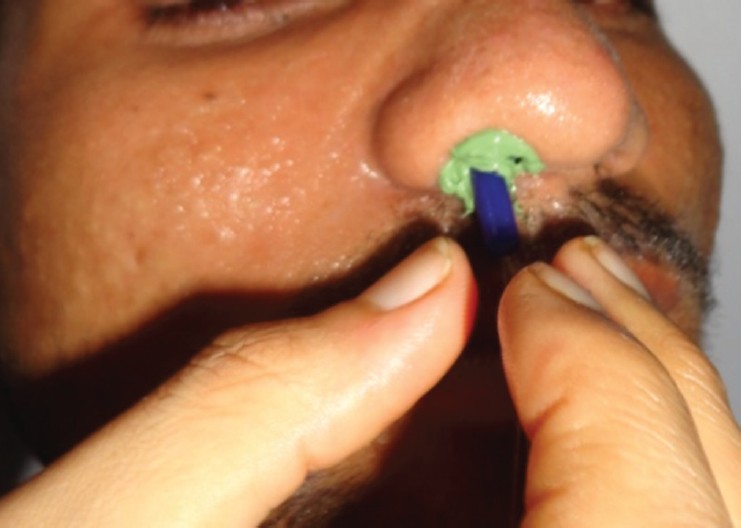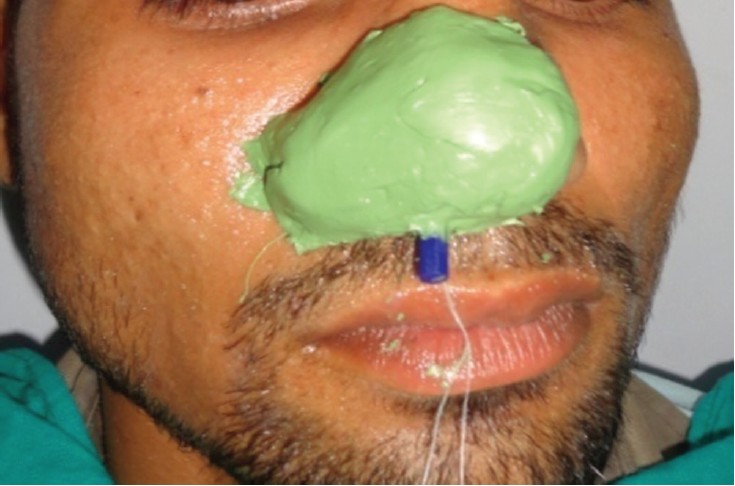|
 
 |
| CASE REPORT |
|
| Year : 2014 | Volume
: 9
| Issue : 2 | Page : 93-96 |
|
Novel use of ear plug for making intranasal impression
Manu Rathee, Mohaneesh Bhoria, Renu Kundu
Department of Prosthodontics, Post Graduate Institute of Dental Sciences, Pt. B.D. Sharma University of Health Sciences, Rohtak, Haryana, India
| Date of Web Publication | 9-Dec-2014 |
Correspondence Address:
Manu Rathee
Department of Prosthodontics, Post Graduate Institute of Dental Sciences, Pt. B.D Sharma University of Health Sciences, Rohtak, Haryana
India
  | Check |
DOI: 10.4103/1858-5000.146584 
The intranasal splint, stent, and septal obturator are indicated to maintain the patency of the nasal passage. The intranasal prosthetic aid fabrication requires recording of the intranasal anatomy. The problem encountered while making intranasal impression is to carry the impression material into nostrils because the anatomic constriction of the nasal cavity or the contracture caused by trauma or surgery prevents the making of the accurate impression. The thin consistency of elastic impression material used for this purpose does not provide enough resistance required for an extension of alae. The impression material is difficult to control as no prefabricated impression trays are available. An innovative use of ear plug for making intranasal impression is described. The use of ear plug serves to carry and support the impression material during insertion and setting. The flexibility of the ear plug permits easy removal after impression material is set. Keywords: Intranasal splint, nasal impression, nasal stent
How to cite this article:
Rathee M, Bhoria M, Kundu R. Novel use of ear plug for making intranasal impression. Sudan Med Monit 2014;9:93-6 |
| Introduction | |  |
The face is the most prominent and significant part of the human body, and arguably the nose is its most distinguishable feature of facial identity. [1] Functions of the nose are filtration, heating, and moisturizing of inspired air, in addition to smell and taste. The nose is the only means of bringing warm humidified air into the lungs. [2]
Nasal deformities are produced due to trauma, burns, surgical treatment of malignant diseases or congenital deformation. The surgical reconstruction is required to establish esthetic form for these types of disfigurement. Complications of surgical reconstruction of the nose include constriction of the tissues inward, contraction of the tissues upward, and collapse of the tissues, leading to an unfavorable esthetic result. [3] Contracture of the soft tissue during healing may lead to a loss of airway patency compromising the respiratory function. A temporary or preventive intranasal prosthesis can facilitate early rehabilitation of such cases. Intranasal splint and stent are used for the presurgical management of these congenital or acquired nasal defects, for alar molding, for maintenance of airway patency and to prevent stenosis due to contracture during soft tissue healing.
The intranasal prosthetic aid fabrication requires recording of the intranasal anatomy. The problem encountered while making intranasal impression is to carry the impression material into nostrils because the anatomic constriction of the nasal cavity or the contracture caused by trauma or surgery prevents the making of the accurate impression. The impression material used for making intranasal impression is difficult to control as no prefabricated impression trays are available. A simple impression procedure with an innovative use of ear plug for making intranasal impression is described.
| Clinical procedure | |  |
- The right nostril was packed with petrolatum jelly coated gauze attached to the thread. The nasal packing was to prevent the impression material from being displaced posteriorly [Figure 1]
- A flexible ear plug was used as impression tray to carry the impression material into the nostril
- The ear plug has three concentric rings with increasing diameter at one end and a small stem that can serve as a handle. The rings help to carry and confine the thin consistency impression material and support it during setting. The flexibility of ear plug permits easy insertion and removal of impression [Figure 2]
- The thin consistency silicone impression material was loaded around the rings and inserted into the right nostril [Figure 3]
- The extra impression material was added around the alae of the nose to pick up nasal contour
- Care was taken that the end of the stem of the ear plug was not fully covered with impression material that served as a handle of the tray for easy retrieval of impression [Figure 4]
- After the material had set, the impression was removed easily by holding the stem of the ear plug extending out from the nasal vestibule uncovered by the impression material
- The impression was inspected to verify its completion and poured in a conventional way to get the master cast
- Then the intranasal prosthesis was fabricated on the master cast with clear acrylic resin.
 | Figure 3: Ear plug loaded with impression material inserted into the nostril
Click here to view |
 | Figure 4: Completed impression with extending stem of ear plug for impression retrieval
Click here to view |
| Discussion | |  |
The nasal defects result from trauma, surgery or developmental deformities. The complexity of the nasal anatomical configuration makes surgical reconstruction difficult. [1] Complications of surgical reconstruction of the nose include constriction of the tissues inward, contraction of the tissues upward, and collapse of the tissues, leading to an unfavorable esthetic result. The surgical management of these defects has been assisted by prosthetic aids. [4] The intranasal splint has been widely used to minimize the complications of surgery. [5] The role of nasal splint and nasal stent has been considered as an important factor in successful treatment of cleft defects also. [6]
The objective of prosthetic adjunctive therapy is to record the area of the defect accurately and provide support to the soft tissues in desired position during surgical rehabilitation. [1] Nasal stent is indicated to support the reconstructive tissues to prevent collapse and to avoid a compromised airway patency. It is used to support intranasal skin graft. [7] Nasal stent is utilized to act as an obturator for large nasal septal defects. [8] It has also been used as definitive prosthesis for treating atrophic rhinitis. [9] An intranasal stent with filter has proven to be an effective personal respiratory protective device with acceptable air flow resistance. [10]
Intranasal prosthesis serves as an adjunct for early rehabilitation during the surgical phase of therapy, till the time definitive prosthesis or corrective surgery is planned. The emphasis on capturing all the soft and hard tissue details while making impression is required for fabrication of intranasal prosthesis. However, desired details are often not captured during impression making in the maxillofacial region. [11] It may be due to nonavailability of prefabricated suitable impression trays for this region. Impression making is the initial problem for a facial region where perforations or openings are present, and it may be challenging. There have been incidences of impression material being displaced in the nasal floor or maxillary antrum though it may go unnoticed for long periods postoperatively. [12]
Adequate support, retention, and stability of the intranasal prosthesis require proper extension into the nasal cavity. The concentric rings of ear plug used as an impression tray provide the required alar distension for retention of the intranasal prostheses and ensure detailed impression when capturing the intranasal anatomy. The use of ear plug for making intranasal impression is a convenient method. It aids in carrying the impression material into the nasal vestibule, permits easy retrieval of impression by holding the stem of the ear plug and thus enables the dentist to make a good intranasal impression. An accurate impression forms the foundation for intranasal prostheses, splints, and stents fabricated to support and maintain tissue position, airway patency, reduce postsurgical contracture and adhesions. [13]
| Conclusion | |  |
This article describes a simple procedure that can assist the clinician in capturing the intranasal anatomy while making impressions for intranasal prostheses. The impression technique described takes advantage of the flexibility and rigidity of ear plug that was used as an impression tray for making the intra nasal impression. Advantages of the use of ear plug include it's simple, easy to use, cost effective, inexpensive and readily available, thus may be used for making impression for intranasal splints, stents and intranasal prostheses.
| References | |  |
| 1. | Brooks MD, Carr AB, Eckert SE. Nasal stent fabrication involved in nasal reconstruction: Clinical report of two patient treatments. J Prosthet Dent 2004;91:123-7.  |
| 2. | Des Jardins T. Cardiopulmonary Anatomy and Physiology. 4 th ed. New York: Delmar Learning; 2002.  |
| 3. | Burget GC, Menick FJ. Nasal support and lining: The marriage of beauty and blood supply. Plast Reconstr Surg 1989;84:189-202.  |
| 4. | Toljanic JA, Lee J, Bedard JF. Temporary nasal prosthesis rehabilitation: A clinical report. J Prosthet Dent 1999;82:384-6.  |
| 5. | Campbell JB, Watson MG, Shenoi PM. The role of intranasal splints in the prevention of post-operative nasal adhesions. J Laryngol Otol 1987;101:1140-3.  |
| 6. | Hou YX, Ren ZP, Li JF, Li XL, Ma SW, Cao HQ. Presurgical nasoalveolar molding in infants with cleft lip and palate: Analysis of 29 cases. Shanghai Kou Qiang Yi Xue 2011;20:641-4.  |
| 7. | Wong F, Smith CR. Surgical stent fabrication for unilateral nasal obstruction of the anterior portion of the nasal airway. J Prosthodont 2009;18:272-5.  |
| 8. | Zaki HS, Myers EN. Prosthetic management of large nasal septal defects. J Prosthet Dent 1997;77:335-8.  |
| 9. | Nagaraj E, Shetty N, Mankani N, Rao SM, Gurram SK. Nasal stent fabrication for an atrophic rhinitis patient: A simplified technique. J Clin Diagn Res 2012;6:530-2.  |
| 10. | Tanpowpong K. Personal respiratory protective devices: Efficacy of intranasal stent with filters. J Med Assoc Thai 2000;83:21-7.  [ PUBMED] |
| 11. | Psillakis JJ, Wright RF, Toothaker RW. A simple, expeditious method for placement of thermoplastic impression material for speech aid prostheses. J Prosthet Dent 1999;81:247-8.  |
| 12. | Dimitrakopoulos I, Papadaki M. Foreign body in the maxillary sinus: Report of an unusual case. Quintessence Int 2008;39:698-701.  |
| 13. | Seals RR Jr, Bohnenkamp LG, Parel SM. Intranasal prostheses, splints, and stents. J Prosthet Dent 1988;60:595-601.  |
[Figure 1], [Figure 2], [Figure 3], [Figure 4]
|